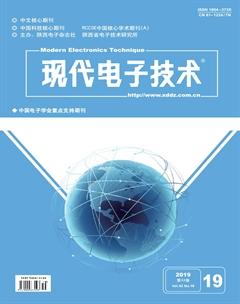關于長大隧道通風排污優化控制仿真設計
黃艷國 房罡 李向邯 陳超 張碩



摘 ?要: 在長大隧道通風排污優化控制系統中,由于受到隧道內車流量改變以及外界環境變化的影響,傳統采用的固定論域的模糊控制方法往往無法有效地降低污染物濃度,還極易造成通風風機的不必要浪費。為解決上述問題,提出一種基于粒子群優化算法的變論域模糊控制策略,通過建立隧道內通風風量的數學模型,分析通風排污過程中控制目標的性能指標,利用粒子群優化算法在線對伸縮因子進行尋優,以此動態調整模糊控制器輸入、輸出量的論域,從而改善隧道環境參數。搭建 Matlab/Fuzzy仿真平臺完成系統仿真并與傳統模糊控制器進行比較,仿真結果顯示優化后的控制方法與傳統控制方法相比,可以有效地抑制污染物濃度并且達到了較好的節能目的。
關鍵詞: 隧道通風; 排污; 污染物稀釋; 模糊控制; 優化控制; 實驗仿真; 節能
中圖分類號: TN876?34; TB24 ? ? ? ? ? ? ? ? ? ?文獻標識碼: A ? ? ? ? ? ? ? ? ? ? ?文章編號: 1004?373X(2019)19?0144?05
Abstract: As for the ventilation and pollution discharge system of long tunnels, the traditional fuzzy control method using fixed?universe domain is often affected by change in traffic flow in the tunnel and change in the external environment, so it usually can not reduce the pollutant concentration effectively, and is easy to result in unnecessary waste of the ventilation fan. In order to solve the above problems, a variable universe fuzzy control strategy based on particle swarm optimization algorithm is proposed. The performance index of control goal in the ventilation and pollution discharge is analyzed with the mathematic model established for determining the ventilation volume in tunnel. The particle swarm optimization algorithm is used to optimize the contraction?expansion factor on line, and the input and output domains of the fuzzy controller are dynamically adjusted, so as to to optimize the tunnel required air volume and improve the tunnel environment. The Matlab/Fuzzy simulation platform is build to complete the system simulation and compare it with the traditional fuzzy controller. The simulation results show that the optimized control method can more effectively suppress the pollutant concentration and achieve the better energy?saving purpose, in comparison with the traditional control method.
Keywords: tunnel ventilation; pollution discharge; pollutant dilution; fuzzy control; optimization control; experimental simulation; energy conservation
0 ?引 ?言
隧道通風控制系統具有非線性、時變性以及遲滯性等特點,其作用和設計的相關技術已經成為熱門研究之一[1]。長大公路隧道有效的通風控制不但能節省資源的消耗,還能為車輛通行提供良好的行車環境。模糊控制由于結構簡單、魯棒性強且不用對研究對象進行復雜的建模處理,在隧道通風領域已經被證實具有很強的實用性。隨著近些年國內外專家學者對隧道通風模糊控制進行深入系統性分析研究,在通風排污方面已經取得了較大的成效。文獻[2]基于交通量及天氣影響對隧道需風量進行計算,并利用模糊理論對風機進行控制,以此來降低污染物濃度;文獻[3]運用T?S模糊辨識法對隧道污染物濃度變化量進行提前預測,用于提前優化隧道內的風機數量;文獻[4]將系統檢測的CO值和煙霧VI值與其設定值的差值作為控制器的模糊輸入變量,從而實現了隧道通風的合理控制。然而在長大隧道通風調節過程中,這些基于傳統模糊控制的排污方法采用的輸入與輸出量論域都是固定不變的,這就導致控制規則不足,運行中所耗費的能源較大。針對上述不足,眾多的研究學者對模糊控制進行了各種改進,如自適應積分滑模模糊控制[5]、模糊神經網絡控制[6]等。因此,本文在借鑒前人的優化模糊控制方法的基礎上,提出將變論域模糊理念運用到隧道通風排污系統中。利用CO濃度作為控制目標,將粒子群優化算法應用于對伸縮因子的智能尋優,以此構成變論域模糊控制器,從而改善隧道環境[7]。





3 ?結 ?語
通過對隧道通風排污系統的優化設計,將變論域模糊器應用在隧道通風控制中。與隧道固定論域的模糊控制相比,不但實現了能源的節約,而且降低了風機使用頻率和臺數,延長了通風機的使用壽命。通過仿真實驗證明,本系統可降低能耗約6.5%,有效減少了隧道運營成本。
參考文獻
[1] 邢榮軍,徐湃,蔣樹屏,等.交通隧道CO動態濃度控制指標研究[J].地下空間與工程學報,2018,14(2):530?535.
XING Rongjun, XU Pai, JIANG Shuping, et al. Research on CO dynamic concentration control indicato r in traffic tunnel [J]. Chinese journal of under ground space and engineering, 2018, 14(2): 530?535.
[2] HRBCEK J, SPALEK J, ?IM?K V. Process model and implementation the multivariable model predictive control to ventilation system [C]// 2010 IEEE 8th International Symposium on Applied Machine Intelligence and Informatics (SAMI). Herlany: IEEE, 2010: 211?214.
[3] 楊宇,周奎寧,程軍圣.模糊辨識在隧道縱向式通風控制中的應用[J].計算機工程與應用,2014,50(4):245?249.
YANG Yu, ZHOU Kuining, CHENG Junsheng. Application of fuzzy identification to road tunnel longitudinal ventilation control [J]. Computer engineering and applications, 2014, 50(4): 245?249.
[4] 林強,劉明華,茹鋒,等.隧道通風系統模糊控制算法研究[J].公路交通科技,2010,27(9):85?88.
LIN Qiang, LIU Minghua, RU feng, et al. Study on fuzzy control algorithm for tunnel ventilation system [J]. Highway traffic technology, 2010, 27(9): 85?88.
[5] TAN Z, HUANG Z Y, WU K, et al. Simulation analysis of longitudinal ventilation system with jet fan speed control for MPC strategy in a road tunnel [C]// 2012 15th International IEEE Conference on Intelligent Transportation Systems. Ancho?rage: IEEE, 2012: 1471?1476.
[6] TAN Zhen, XIA Yingjie, YANG Qinmin, et al. Adaptive fine pollutant discharge control for motor vehicles tunnels under traffic state transition [J]. IET intelligent transport systems, 2015, 9(8): 783?791.
[7] 馬潔榮,任淑萍.改進的粒子群優化算法的研究[J].科技創新與生產力,2017(9): 94?96.
MA Jierong, REN Shuping. Research of improved particle swarm optimization algorithm [J]. Sci?tech innovation and productivity, 2017(9): 94?96.
[8] 彭靈志,賀建軍.基于粒子群算法的變論域模糊控制策略[J].控制工程,2012,19(z1):116?118.
PENG Lingzhi, HE Jianjun. Variable universe fuzzy control based on particle swarm optimization algorithm [J]. Control engineering of China, 2012, 19(S1): 116?118.
[9] 褚鵬宇,劉瀾,尹俊淞,等.融合時空信息的短時交通流預測[J].計算機工程與應用,2016,52(12):246?250.
CHU Pengyu, LIU Lan, YIN Junsong, et al. Short?term traffic flow forecasting by fusing spatial?temporal traffic information [J]. Computer engineering and applications, 2016, 52(12): 246?250.
[10] KUESEL T R, KING E H, BICKEL J O. Tunnel engineering handbook [M]. [S.l.]: Springer Science & Business Media, 1996.
[11] 張曉松,金濤,林東.高速公路隧道通風系統的多參量模糊控制研究[J].重慶交通大學學報(自然科學版),2016,35(4):20?24.
ZHANG Xiaosong, JIN Tao, LIN Dong. Research on multi?parameter fuzzy control algorithm of highway tunnel ventilation system [J]. Journal of Chongqing Jiaotong University (Na?tural science), 2016, 35(4): 20?24.
[12] 趙航.基于模糊PID控制的通風風量調節系統研究[J].現代電子技術,2016,39(16):125?127.
ZHAO Hang. Study on ventilation air quantity control system based on fuzzy PID control [J]. Modern electronics technique, 2016, 39(16): 125?127.
[13] DEEPAK K A, ABDUL S K, SUBHAM K S. Application of genetic fuzzy system for damage identification in cantilever beam structure [J]. Procedia engineering, 2016, 144: 215?225.
[14] 趙希梅,任成一,劉浩.微創手術導管機器人系統變論域模糊PID控制[J].計算機仿真,2015,32(1):357?360.
ZHAO Ximei, REN Chengyi, LIU Hao. Variable universe fuzzy PID control for minimally invasive operation robotic catheter system [J]. Computer simulation, 2015, 32(1): 357?360.
[15] 龔超.長大隧道施工過程中的通風技術[J].公路,2014,59(5):167?170.
GONG Chao. Ventilation technology in construction of long and long tunnel [J]. Highway, 2014, 59(5): 167?170.
[16] WU Ke, YANG Qinmin, KANG Cheng, et al. Adaptive critic design based control of tunnel ventilation system with variable jet speed [J]. Journal of signal processing systems, 2017, 86(2/3): 269?278.

